Beth Trissel's Blog, page 100
March 6, 2011
The Lure of Time Travel & Read an Ebook Week~
 As an historical romance author, I suppose all of my stories are time travels in a sense, but the first time I incorporated actual visits to the past was in the form of flashbacks to early nineteenth century Virginia in my murder mystery/ghost story romance novel, Somewhere My Love. Following that, my ultimate challenge was to set a time travel romance novel in Scotland.
As an historical romance author, I suppose all of my stories are time travels in a sense, but the first time I incorporated actual visits to the past was in the form of flashbacks to early nineteenth century Virginia in my murder mystery/ghost story romance novel, Somewhere My Love. Following that, my ultimate challenge was to set a time travel romance novel in Scotland.
Slight problem, and one that held me back for years, I've never actually been there, though many of my family have and told me all about its grandeur and charm. Certainly, I've read, heard, and seen many descriptions of Scotland. Being a history buff I've read up on and watched numerous programs set in the British Isles.
 I'm a British junkie, an anglophile, while equally preoccupied with early America. But then America and Great Britain are both tied together, and were especially linked in the colonial time period. Virginia's Shenandoah Valley where I live and my family has lived for several hundred years resembles Scotland and Ireland and is partly why so many Scots/Irish settled here in the 18th century. So that gave me an 'in.'
I'm a British junkie, an anglophile, while equally preoccupied with early America. But then America and Great Britain are both tied together, and were especially linked in the colonial time period. Virginia's Shenandoah Valley where I live and my family has lived for several hundred years resembles Scotland and Ireland and is partly why so many Scots/Irish settled here in the 18th century. So that gave me an 'in.'
 Until SOMEWHERE MY LASS I'd set all my stories in America, past and present. This departure to Scotland was a challenge, but I drew deeply on my English Scots-Irish roots, which I've been doing all along. Apart from the prominent Native American heroes and characters in my work (Through the Fire, Red Bird's Song, Daughter of the Wind) the others are English-Scots-Irish, with a smidgen of French. My ancestors have a smidgen of French in the meld—a Norman knight who sailed and fought with William the Conqueror.
Until SOMEWHERE MY LASS I'd set all my stories in America, past and present. This departure to Scotland was a challenge, but I drew deeply on my English Scots-Irish roots, which I've been doing all along. Apart from the prominent Native American heroes and characters in my work (Through the Fire, Red Bird's Song, Daughter of the Wind) the others are English-Scots-Irish, with a smidgen of French. My ancestors have a smidgen of French in the meld—a Norman knight who sailed and fought with William the Conqueror.
But I digress. A little more about the inspiration behind light paranormal romance SOMEWHERE MY LASS:
 As is often the case, the opening of this book was inspired by a dream, as was my recently completed light paranormal/time travel romance, Somewhere The Bells Ring. These vivid dreams grab my attention and make me wonder where in the world I go from here. Inquiring minds like mine want to know the rest of the story so I delve & plot & lie awake nights trying to recapture the dream and see where it leads. Oh, and I finally dreamed the opening to the much pondered sequel to Somewhere My Lass so maybe I'll make progress and Fergus shall have his story.
As is often the case, the opening of this book was inspired by a dream, as was my recently completed light paranormal/time travel romance, Somewhere The Bells Ring. These vivid dreams grab my attention and make me wonder where in the world I go from here. Inquiring minds like mine want to know the rest of the story so I delve & plot & lie awake nights trying to recapture the dream and see where it leads. Oh, and I finally dreamed the opening to the much pondered sequel to Somewhere My Lass so maybe I'll make progress and Fergus shall have his story.
 Ultimately Somewhere My Lass, and my other works for that matter, evolve from lengthy research, in this case into my distant Scottish roots. And along with that, a long-held fascination with the idea of actually being transported to the past, with a proviso that I can return to the present whenever the thrill wears off. Say, by tea time. My characters are far more adventurous than I. I doubt I'd survive a week back then.
Ultimately Somewhere My Lass, and my other works for that matter, evolve from lengthy research, in this case into my distant Scottish roots. And along with that, a long-held fascination with the idea of actually being transported to the past, with a proviso that I can return to the present whenever the thrill wears off. Say, by tea time. My characters are far more adventurous than I. I doubt I'd survive a week back then.
 Without a doubt, I've been influenced by my beloved C S Lewis in his Chronicles of Narnia that I grew up reading. I'm still looking for Narnia. Isn't everyone? And movies like Back to the Future and Timeline (I don't care what the critics say I loved it) The Time Traveler's Wife... And there were other films and books, but I like to think I've achieved an original take on the oft visited time travel theme.
Without a doubt, I've been influenced by my beloved C S Lewis in his Chronicles of Narnia that I grew up reading. I'm still looking for Narnia. Isn't everyone? And movies like Back to the Future and Timeline (I don't care what the critics say I loved it) The Time Traveler's Wife... And there were other films and books, but I like to think I've achieved an original take on the oft visited time travel theme.
 Of course, my love for old castles and the Scottish Highlands also lent inspiration. The concept behind my SOMEWHERE series is that the story opens in modern-day, so far my home state of Virginia and I don't see that changing, and then transports the reader SOMEWHERE else–either back to an earlier time in the same house, as in SOMEWHERE MY LOVE, or another place altogether, as in SOMEWHERE MY LASS. Sounds simple enough, right? But writing these stories isn't. And then there are the questions that haunt me. Did I get the setting right? Only those of you who dwell in that beautiful land or have visited Scotland can say.
Of course, my love for old castles and the Scottish Highlands also lent inspiration. The concept behind my SOMEWHERE series is that the story opens in modern-day, so far my home state of Virginia and I don't see that changing, and then transports the reader SOMEWHERE else–either back to an earlier time in the same house, as in SOMEWHERE MY LOVE, or another place altogether, as in SOMEWHERE MY LASS. Sounds simple enough, right? But writing these stories isn't. And then there are the questions that haunt me. Did I get the setting right? Only those of you who dwell in that beautiful land or have visited Scotland can say.
Neil MacKenzie's well ordered life turns to chaos when Mora Campbell shows up claiming he's her fiancé from 1602 Scotland. Her avowal that she was chased to the future by clan chieftain, Red MacDonald, is utter nonsense, and Neil must convince her that she is just addled from a blow to her head–or so he believes until the MacDonald himself shows up wanting blood. Mora knows the Neil of the future is truly her beloved Niall who disappeared from the past. Although her kinsmen believe he's dead, and she is now destined to marry Niall's brother, she's convinced that if she and Neil return to the past, all will be right.
 The only problem is how to get back to 1602 before it's too late. The balance of the present and future are in peril if she marries another, and the Neil of the present will cease to exist. An ancient relic and a few good friends in the future help pave the way back to the past, but will Mora and Neil be too late to save a love that began centuries before?~
The only problem is how to get back to 1602 before it's too late. The balance of the present and future are in peril if she marries another, and the Neil of the present will cease to exist. An ancient relic and a few good friends in the future help pave the way back to the past, but will Mora and Neil be too late to save a love that began centuries before?~
SOMEWHERE MY LASS is available in digital download at The Wild Rose Press , Amazon Kindle, Barnes & Noble's Nook book, and other online booksellers.
*SOMEWHERE MY LASS and SOMEWHERE MY LOVE were both featured on Barbara Vey's blog at Publisher's Weekly.
In honor of read an ebook week I'm giving away a digital download of Somewhere My Love & Somewhere My Lass to one of the visitors who leaves me a comment on this post. Winner announced next Sunday. *If you've already read them feel free to leave me a high five and cheer the troops. 
Filed under: Uncategorized Tagged: Amazon kindle, British Isles, free digital romance book, FREE ebook, Neil MacKenzie, Read an ebook week participating author, romance ebook giveaway, Scotch-Irish American, Scotland, Scottish highlands, Shenandoah Valley, The Time Traveler's Wife, time travel, Time travel romance novel giveaway, time travelers wife, timetravel, Virginia








March 5, 2011
Downton Abbey
 After a bout of illness forced me to languish on the couch for several days, I was delighted to discover Netflix, God bless 'em, had added the first series of Masterpiece Theater's Downton Abbey to their instant queue. And, Glory Hallelujah, what a brilliant production!
After a bout of illness forced me to languish on the couch for several days, I was delighted to discover Netflix, God bless 'em, had added the first series of Masterpiece Theater's Downton Abbey to their instant queue. And, Glory Hallelujah, what a brilliant production!
 Superbly written and cast, the series unfolds amid spectacular historic settings worth viewing for that aspect alone, but you don't have to hang on simply for the view, Downton Abby has an intriguing plot and subplots. The story is set against a society undergoing rapid alteration from the formal Edwardian Era to a more modern one (1912-1914). And I'd recently researched the early 20th century for the flashback/time travel element in my completed (as of last week) light paranormal romance Somewhere The Bells Ring. So, Downton Abbey was perfectly timed for my interests.
Superbly written and cast, the series unfolds amid spectacular historic settings worth viewing for that aspect alone, but you don't have to hang on simply for the view, Downton Abby has an intriguing plot and subplots. The story is set against a society undergoing rapid alteration from the formal Edwardian Era to a more modern one (1912-1914). And I'd recently researched the early 20th century for the flashback/time travel element in my completed (as of last week) light paranormal romance Somewhere The Bells Ring. So, Downton Abbey was perfectly timed for my interests.
 This series opens with the sinking of the Titanic and explores how the loss of the heir to the estate and the arrival of the new heir apparent affects the fate of the family living at Downton Abbey, one of the most magnificent English homes I've ever seen. Can you imagine actually living in such a place? Boggles the mind. Of course the highborn family take it for granted.
This series opens with the sinking of the Titanic and explores how the loss of the heir to the estate and the arrival of the new heir apparent affects the fate of the family living at Downton Abbey, one of the most magnificent English homes I've ever seen. Can you imagine actually living in such a place? Boggles the mind. Of course the highborn family take it for granted.
 The lives of the servants are a major part of the story and interwoven with those of the gentry who depend on their staff…maids, footmen, butler, housekeeper, valet…to do everything for them, and this is back in the day when one dressed formally for dinner. Every facet of his lordship's daily regimen, and that of the ladies of the household, was to be exacted with absolute correctness and the house run like a well oiled machine.
The lives of the servants are a major part of the story and interwoven with those of the gentry who depend on their staff…maids, footmen, butler, housekeeper, valet…to do everything for them, and this is back in the day when one dressed formally for dinner. Every facet of his lordship's daily regimen, and that of the ladies of the household, was to be exacted with absolute correctness and the house run like a well oiled machine.
 Only it's not a machine. As this series takes pains to portray, these are real people with real wants, needs, wishes…and a new age is dawning when the staff have increasingly more options than remaining in service. Downton Abbey depicts these social evolutions, including the movement for womens' rights and the vote. Nothing vital to that era is overlooked. I'm wowed by the terrific job everyone responsible for this production did, a fresh twist on another much loved series, Masterpiece Theater's Upstairs Downstairs.
Only it's not a machine. As this series takes pains to portray, these are real people with real wants, needs, wishes…and a new age is dawning when the staff have increasingly more options than remaining in service. Downton Abbey depicts these social evolutions, including the movement for womens' rights and the vote. Nothing vital to that era is overlooked. I'm wowed by the terrific job everyone responsible for this production did, a fresh twist on another much loved series, Masterpiece Theater's Upstairs Downstairs.
 As I suspected, Downton Abbey ended with the beginning of World War One, and I anticipate the Great War will feature prominently in the next series which I eagerly anticipate. I could just watch the show on tv, but if I wait until the new series is concluded and uploaded in its entirety to Netflix I can view episode after episode without having to wait until the next week. So, until then…
As I suspected, Downton Abbey ended with the beginning of World War One, and I anticipate the Great War will feature prominently in the next series which I eagerly anticipate. I could just watch the show on tv, but if I wait until the new series is concluded and uploaded in its entirety to Netflix I can view episode after episode without having to wait until the next week. So, until then…

Filed under: Uncategorized Tagged: BBC, Downton Abbey, Edwardian era, England, English language, masterpiece, Masterpiece (TV series), Netflix, Public Broadcasting Service, Upstairs Downstairs, World War I








March 4, 2011
The Country Diary of An Edwardian Lady
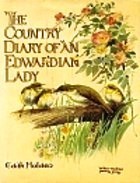 This exquisitely beautiful book came to my attention last summer in Black Mountain, North Carolina while my mother, daughter, and I were browsing a quaint used bookstore–a fitting book for a charming store. Dated 1906, the journal spans the changing seasons with wonderful illustrations painted by the Edwardian Lady herself, Edith Holden. The highly talented Edith weaves in quotes and poems fitting to the season or plant uppermost in her mind on any given day, as well as her thoughts and observations on the wildlife surrounding her home in the village of Olton, Warwickshire, England.
This exquisitely beautiful book came to my attention last summer in Black Mountain, North Carolina while my mother, daughter, and I were browsing a quaint used bookstore–a fitting book for a charming store. Dated 1906, the journal spans the changing seasons with wonderful illustrations painted by the Edwardian Lady herself, Edith Holden. The highly talented Edith weaves in quotes and poems fitting to the season or plant uppermost in her mind on any given day, as well as her thoughts and observations on the wildlife surrounding her home in the village of Olton, Warwickshire, England.
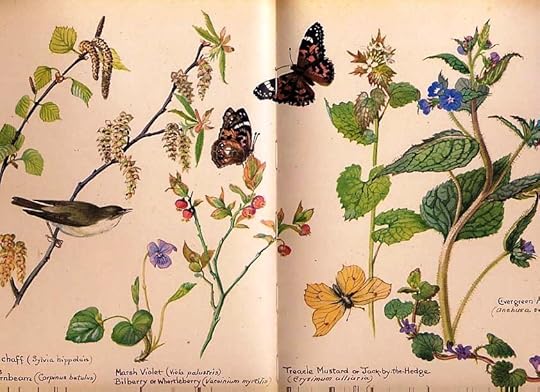 Apparently Edith kept her journal hidden away and it wasn't discovered for seventy years. The diary was then published posthumously in 1977, the copyright date of the book I chanced upon. I'm not sure the extremely private Edith would approve, but her lovely journal has been a blessing to many.
Apparently Edith kept her journal hidden away and it wasn't discovered for seventy years. The diary was then published posthumously in 1977, the copyright date of the book I chanced upon. I'm not sure the extremely private Edith would approve, but her lovely journal has been a blessing to many.
The Country Diary of An Edwardian Lady is a delight for gardener/ nature lovers, and anyone who appreciates beauty. Her writing and illustrations are wonderful.
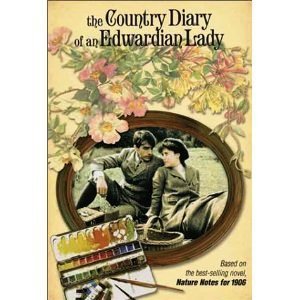 Of course, Amazon has some used copies available. And the journal was the basis for a television series released in 1984.
Of course, Amazon has some used copies available. And the journal was the basis for a television series released in 1984.
Of the month of March she says (in part~she has pages on March):
"Gathered some of the young crimson catkins of the black poplar. The last few days have been very cold and dry with a keen north wind, and any quantity of March dust in evidence. This morning I saw Frog spawn which had been brought in from a pond….
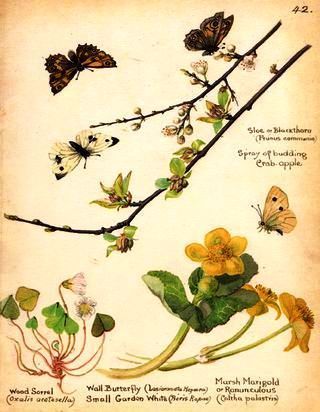 Cycled to Bushwood on a still, grey day with beautifully dry roads. March is going out like a lamb….the woods will be carpeted with primroses in a week or twos' time, but I found quantities of primroses and sweet violets both blue and white on the banks of the fields and the roadsides. I found the first dog violet I have seen in blossom this year at the top of Dick's Lane; the cowslips are only in bud yet, but everywhere the celandine made the ditches bright, and the strawberry leaved cinquefoil spangled the banks…I saw two robins' and two blackbirds' nests…and a number of sweet birds as I spun along between the hedges. A tiny greenish grey bird flashed across the road, I thought for a minute it was a warbler, but as it emerged into sight again I saw it was a golden-crested wren.
Cycled to Bushwood on a still, grey day with beautifully dry roads. March is going out like a lamb….the woods will be carpeted with primroses in a week or twos' time, but I found quantities of primroses and sweet violets both blue and white on the banks of the fields and the roadsides. I found the first dog violet I have seen in blossom this year at the top of Dick's Lane; the cowslips are only in bud yet, but everywhere the celandine made the ditches bright, and the strawberry leaved cinquefoil spangled the banks…I saw two robins' and two blackbirds' nests…and a number of sweet birds as I spun along between the hedges. A tiny greenish grey bird flashed across the road, I thought for a minute it was a warbler, but as it emerged into sight again I saw it was a golden-crested wren.
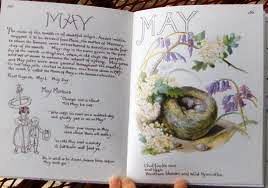 …March has been a very cold month, but dry on the whole. There were two or three bright genial days in the first week that were like a foretaste of summer."
…March has been a very cold month, but dry on the whole. There were two or three bright genial days in the first week that were like a foretaste of summer."
"Daffodils that come before the swallow dares, And take the winds of March with beauty." ~Shakespeare
Filed under: Uncategorized Tagged: Australia, Edith Holden, Edwardian era, gardening journal, London, nature lover, nature notes, Nick Clegg, Olton, seasonal nature journal, The Country Diary of An Edwardian Lady, United States








March 1, 2011
Let's Call It Spring!
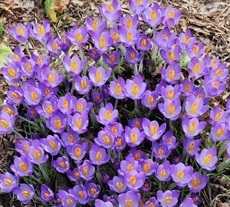 At long last, today is the first of March. After spending much of January and most all of February sick with one thing or another, I tottered forth into the sunshine and managed to accomplish a few much-needed errands. Now I'm whacked and feeling it's time for a nap. That's what seemingly endless virus's will do to a body. Considering I'm not the only sufferer in the Shenandoah Valley or the country, I think most everyone except the die-hard skiing fanatics would agree that what we all need is SPRING! A tonic to mind, body, and spirit.
At long last, today is the first of March. After spending much of January and most all of February sick with one thing or another, I tottered forth into the sunshine and managed to accomplish a few much-needed errands. Now I'm whacked and feeling it's time for a nap. That's what seemingly endless virus's will do to a body. Considering I'm not the only sufferer in the Shenandoah Valley or the country, I think most everyone except the die-hard skiing fanatics would agree that what we all need is SPRING! A tonic to mind, body, and spirit.
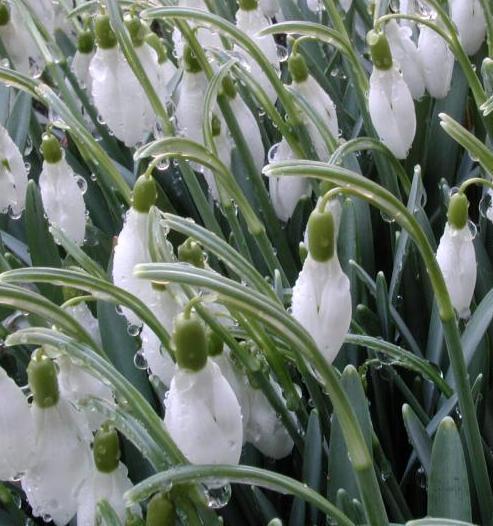 To that end, I point out the snow crocus and snowdrops blooming here and there in sheltered spots of my yard and garden. Welcome green shoots of crocus, daffodils, tulips…are pushing up through the earth most everywhere, and tomorrow the weather is to be sunny and 60 degrees. The pussy willow is bursting forth with catkins, and fussy barnyard geese are laying eggs. I conclude it's early spring and much prefer that term to 'late winter.' Far more mood brightening.
To that end, I point out the snow crocus and snowdrops blooming here and there in sheltered spots of my yard and garden. Welcome green shoots of crocus, daffodils, tulips…are pushing up through the earth most everywhere, and tomorrow the weather is to be sunny and 60 degrees. The pussy willow is bursting forth with catkins, and fussy barnyard geese are laying eggs. I conclude it's early spring and much prefer that term to 'late winter.' Far more mood brightening.
In keeping with the season, I'm sorting through boxes stuffed with envelopes of seeds leftover from the past year or two and ordering more (we count our wealth in seeds) as well as potatoes, strawberries, culinary herbs and all things garden. Which as far as I'm concerned equals all things good as any true gardener will agree. I also save seed, am a big fan of heirloom seeds, and have been known to share so I'm not simply hording my treasure trove.
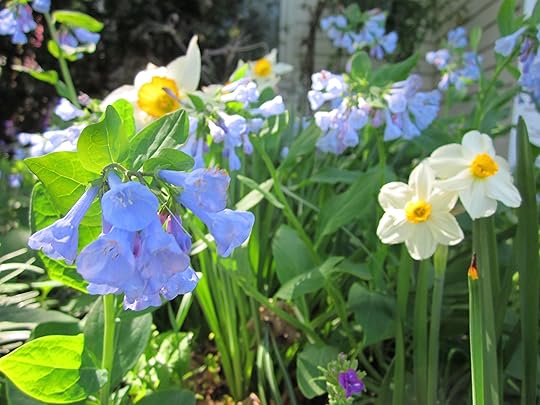 An excellent place to be for those in want of plants is out in the garden with me on a fine spring day while I divide perennials and thin overly generous larkspur, love in a mist, and poppy seedlings…I'll soon tire, allowing them to take over certain spots of the garden, but in the beginning I'm imbued with the determination that this year all will be in order. I soon concede to a more wildflower look and justify many of the weeds as 'kind of pretty.' We definitely have a wildlife habitat here, another justification for the unkempt tangle that encroaches as the season unfolds. But now, all is fresh, new, and filled with promise.
An excellent place to be for those in want of plants is out in the garden with me on a fine spring day while I divide perennials and thin overly generous larkspur, love in a mist, and poppy seedlings…I'll soon tire, allowing them to take over certain spots of the garden, but in the beginning I'm imbued with the determination that this year all will be in order. I soon concede to a more wildflower look and justify many of the weeds as 'kind of pretty.' We definitely have a wildlife habitat here, another justification for the unkempt tangle that encroaches as the season unfolds. But now, all is fresh, new, and filled with promise.
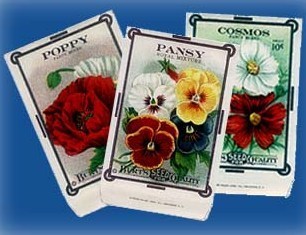 In my search of every more seeds on the internet I came across an interesting site with images of vintage seed packets for sale: http://www.seedart.com/flowers.html
In my search of every more seeds on the internet I came across an interesting site with images of vintage seed packets for sale: http://www.seedart.com/flowers.html
Filed under: Uncategorized Tagged: Bulb, Christmas, Crocus, Galanthus, Garden, Home & Garden, Plant, Seed, Shenandoah Valley, Shopping, Sowing, Spring (season), Tulip, Weather








February 25, 2011
The Talented Maeve Greyson Is My Guest~
 I'm delighted to have Maeve with me. She's a lovely, gracious lady and has made it to an impressive level in the Kensington Brava / RT Book Reviews Writing with the Stars contest. I'll let Maeve tell us a little about her intriguing entry, her recent release, and herself. Take it away, Maeve~
I'm delighted to have Maeve with me. She's a lovely, gracious lady and has made it to an impressive level in the Kensington Brava / RT Book Reviews Writing with the Stars contest. I'll let Maeve tell us a little about her intriguing entry, her recent release, and herself. Take it away, Maeve~
 Not every first meeting is love at first sight…
Not every first meeting is love at first sight…
I admit it. I love a good spat between the hero and heroine. I've always heard there's a fine line between love and hate and I adore romances that push the limit. I know you've read them. The hero picks at the heroine until she snaps –or vice versa. They explode into a heated tirade and end up in each other's arms. I often wonder if this is some sort of throwback to the days when little boys pestered little girls until they ran home in tears? It seems like the MORE the little boy likes the girl…the more he aggravates her. Come to think of it, I married just such a pestering "little boy". But THAT's another blog. 
 Beth was kind enough to invite me to her lovely blog to talk about my paranormal romance, ETERNITY'S MARK. I'm so excited that my story has made it to the final round of the Kensington Brava / RT Book Reviews Writing with the Stars contest. I wanted to share a "never before shared" excerpt. So, I decided Taggart and Hannah's first meet would be a lovely taste. Hannah's irritated that she's been interrupted from a very emotional day to meet some stranger in the town's small café. This excerpt gives you a bit of a hint at the sparring about to ensue.
Beth was kind enough to invite me to her lovely blog to talk about my paranormal romance, ETERNITY'S MARK. I'm so excited that my story has made it to the final round of the Kensington Brava / RT Book Reviews Writing with the Stars contest. I wanted to share a "never before shared" excerpt. So, I decided Taggart and Hannah's first meet would be a lovely taste. Hannah's irritated that she's been interrupted from a very emotional day to meet some stranger in the town's small café. This excerpt gives you a bit of a hint at the sparring about to ensue.
I hope you enjoy this glimpse into ETERNITY'S MARK and if you're so inclined to help me bring home the win, I've included the voting link below:
Voting link:
http://www.rtbookreviews.com/content/writing-stars-vote-love-scene
Taggart and Hannah meet:
 The bell on the wire hanging above the door jangled. Taggart knew it was her before he raised his eyes; he sensed it by the way the skin tingled at the base of his neck. Her energy tickled a shiver up his spine. The sacred guardian's aura flooded the room and he was her protector. He would've known she entered his presence even if he had been blind.
The bell on the wire hanging above the door jangled. Taggart knew it was her before he raised his eyes; he sensed it by the way the skin tingled at the base of his neck. Her energy tickled a shiver up his spine. The sacred guardian's aura flooded the room and he was her protector. He would've known she entered his presence even if he had been blind.
Taggart hid his grin behind the white ceramic mug he clasped between his hands. The collective jaws of the Guild of Barac'Nairn would've hit the floor had they been sitting at Taggart's side. Hannah MacPherson, the blessed guardian, was not what they would've expected. Taggart chuckled into the depths of his cup. As far as he was concerned, the fiery lass beamed the definition of pure delight itself.
 The tiny, young woman ordained to be guardian of the sacred Draecna sported a ratty St. Louis Cardinal's baseball cap pulled low over snapping green eyes. Her auburn ponytail exploded through the tattered hole in the back. The tangled mass of curls tumbled down her back as though a windstorm had tossed her into the cafe. Grass and mud stained the ragged knees of her jeans. Her well-worn tee shirt clung to her curves like tissue wrapped around a tempting gift. Taggart sat down his coffee, stretching back in his chair unable to resist chuckling again. He'd never seen a woman don such boots. Steel-toed work boots laced tight about her tiny ankles. She plodded across the room like a heavy construction worker.
The tiny, young woman ordained to be guardian of the sacred Draecna sported a ratty St. Louis Cardinal's baseball cap pulled low over snapping green eyes. Her auburn ponytail exploded through the tattered hole in the back. The tangled mass of curls tumbled down her back as though a windstorm had tossed her into the cafe. Grass and mud stained the ragged knees of her jeans. Her well-worn tee shirt clung to her curves like tissue wrapped around a tempting gift. Taggart sat down his coffee, stretching back in his chair unable to resist chuckling again. He'd never seen a woman don such boots. Steel-toed work boots laced tight about her tiny ankles. She plodded across the room like a heavy construction worker.
He held his breath to keep from laughing aloud as she stalked her way over to the counter. He could tell by the way the woman stomped, she prepared to unleash the hounds of hell if any dared cross her path. Such a fierce small package, she reminded him of the territorial wood nymphs of Glenoc Mur. She'd barely reach the middle of his chest, yet she stood coiled so tight, the woman stood ready to explode.
 The longer Taggart studied her, the more his amusement faded. True, Hannah MacPherson brewed for a fight. Taggart shifted in his seat as the realization hit; he stood centered in her crosshairs. Taggart peered closer. She also suffered; her face revealed a great deal of emotional pain. Her wound simmered deep. Hannah MacPherson might be small but her heart swelled with sorrow.
The longer Taggart studied her, the more his amusement faded. True, Hannah MacPherson brewed for a fight. Taggart shifted in his seat as the realization hit; he stood centered in her crosshairs. Taggart peered closer. She also suffered; her face revealed a great deal of emotional pain. Her wound simmered deep. Hannah MacPherson might be small but her heart swelled with sorrow.
Taggart sucked in a slow breath, struggling against an uncomfortable stirring deep within his chest. His precious guardian had been deeply hurt; she fluttered as a wounded bird. Taggart watched as Hannah's head turned with eyes narrowed when Millie whispered and pointed in his direction. He unfolded his frame and stood beside the table as Hannah whirled and barreled his way.
"Mr. de Gaelson? I believe you wanted to see me? I'm Hannah MacPherson." Hannah stuck out her hand as though daring him to take it and fixed Taggart with a green-eyed glare.
Taggart closed his hand around Hannah's cold, stiff grasp and held it as he leveled with her gaze. "Please, call me Taggart."
 "What can I do for you, Taggart?" Hannah clipped the words with a jerk of her hand, rubbing her fingers as though his touch disturbed her. She shot Millie a brooding glare, her glance sliding back to Taggart as if blaming Millie for his presence.
"What can I do for you, Taggart?" Hannah clipped the words with a jerk of her hand, rubbing her fingers as though his touch disturbed her. She shot Millie a brooding glare, her glance sliding back to Taggart as if blaming Millie for his presence.
Taggart bit back a smile. The woman wasn't going to make his life easy. He read the wariness in Hannah's eyes and the way she'd withdrawn from his touch. Good. She should be wary. It would increase her lifespan and make protecting her somewhat easier, albeit getting close to her and winning her trust could prove even more of a challenge. Taggart nodded toward the table while he motioned for Millie. "Would ye like some coffee while we talk?"
"Not really, thanks." Hannah sent Millie scuttling back around the counter with a single shake of her head. "I don't mean to sound rude, Mr. de Gaelson−"
"Taggart, Ms. MacPherson. Please. I asked ye to call me, Taggart, remember?" Taggart cleared his throat. God's teeth, the stubborn woman insisted on doing things her own way. Lucky for her, they were on this side of the threshold. If they were in Erastaed, he wouldha sifted them to someplace quiet and spelled her. He'd seal her lips and open her ears so she'd have no choice but to hear his words. By Isla's golden beard, she had to see she needed protection. 'Twas time she faced her destiny.
Maeve Greyson writes paranormal romances from her cozy little home in western Kentucky. Tucked away in the middle of nowhere, her stories spark with magic and love, where anything might happen to get to that happily ever after.
Her writing partner, Jasper –the rat terrier/Chihuahua mix, critiques all her work. Under his sharp eye and the endless support of her husband of over thirty-one years, she snuggles back in their secluded wood and pours her daydreams into the keyboard.
 Her debut novel, BEYOND A HIGHLAND WHISPER, just became available from The Wild Rose Press and she recently contracted THE HIGHLANDER'S FURY with them as well.
Her debut novel, BEYOND A HIGHLAND WHISPER, just became available from The Wild Rose Press and she recently contracted THE HIGHLANDER'S FURY with them as well.
Maeve's Links:
Website: http://www.maevegreyson.com/
Blog: http://maevegreyson.blogspot.com/
Facebook: http://www.facebook.com/maeve.greyson OR http://www.facebook.com/maeve.greyson#!/maeve.greyson.page
Twitter: http://twitter.com/#!/maevegreyson
The Wild Rose Press: http://thewildrosepress.com/index.php?main_page=advanced_search_result&search_in_description=1&keyword=maeve+greyson
Filed under: Uncategorized Tagged: Arts, Electric Works, ETERNITY'S MARK, Fiction, Great Britain, Kensington Brava / RT Book Reviews Writing with the Stars contest, Kentucky, Millie, Online Writing, paranormal romance, Romance author Maeve Greyson, Taggart








February 24, 2011
Lovely Reader Review for Enemy of the King
 ENEMY OF THE KING is an excellent and intriguing read. All of the characters are depicted as multi-dimensional and complex, with a mix of positive and negative traits. I don't want to give away the plot, but will just say there are surprising twists, and the author deftly combines both joy and tragedy in this romance novel about the American Revolution. I appreciate that members of each side of the war (both Loyalists and Patriots) are shown in a range from "good" to "evil," unlike many romances in which characters or groups of characters are depicted as only "black or white".
ENEMY OF THE KING is an excellent and intriguing read. All of the characters are depicted as multi-dimensional and complex, with a mix of positive and negative traits. I don't want to give away the plot, but will just say there are surprising twists, and the author deftly combines both joy and tragedy in this romance novel about the American Revolution. I appreciate that members of each side of the war (both Loyalists and Patriots) are shown in a range from "good" to "evil," unlike many romances in which characters or groups of characters are depicted as only "black or white".
Great work, Ms. Trissel!
~Review contributed by Lisbeth Eng's
 1780 South Carolina, spies and intrigue, a vindictive ghost, the battle of King's Mountain, Patriots and Tories, pounding adventure, pulsing romance…
1780 South Carolina, spies and intrigue, a vindictive ghost, the battle of King's Mountain, Patriots and Tories, pounding adventure, pulsing romance…ENEMY OF THE KING
An Adventurous Colonial American Romance Novel
Historical romance novel Enemy of the King on Best Romance Novel list at Buzzle!
BHB Reader's Choice Best Books of 2009
Karin doesn't know who she is—will she find the love of her life in the discovery, or uncover a tragic past and fresh betrayal?
 Step into the elegant parlor of Pleasant Grove, an eighteenth century Georgian plantation built high on the bluff above the Santee River. Admire the elegant lines of this gracious brick home and its exquisite décor. Stroll out into the expansive garden between fragrant borders of lavender and rosemary. Bask beneath the moss-hung branches of an enormous live oak, then saunter back indoors to dress for a candlelight dinner in the sumptuous dining room. But don't plan on a lengthy stay, you're about to be snatched away for a wild ride into Carolina back country.
Step into the elegant parlor of Pleasant Grove, an eighteenth century Georgian plantation built high on the bluff above the Santee River. Admire the elegant lines of this gracious brick home and its exquisite décor. Stroll out into the expansive garden between fragrant borders of lavender and rosemary. Bask beneath the moss-hung branches of an enormous live oak, then saunter back indoors to dress for a candlelight dinner in the sumptuous dining room. But don't plan on a lengthy stay, you're about to be snatched away for a wild ride into Carolina back country.
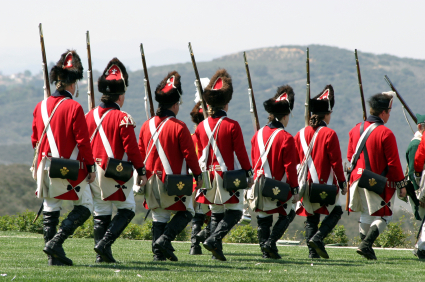 The year is 1780, one of the bloodiest of the American Revolution. The entire Southern garrison has been captured and Lord Cornwallis is marching his forces deep into South Carolina. 'Bloody Ban' Lieutenant Major Banestre Tarleton and his infamous Legion are sweeping through the countryside. Revenge is the order of the day on both sides and rugged bands of militia are all that stand between crown forces and utter defeat.
The year is 1780, one of the bloodiest of the American Revolution. The entire Southern garrison has been captured and Lord Cornwallis is marching his forces deep into South Carolina. 'Bloody Ban' Lieutenant Major Banestre Tarleton and his infamous Legion are sweeping through the countryside. Revenge is the order of the day on both sides and rugged bands of militia are all that stand between crown forces and utter defeat.

Filed under: Uncategorized Tagged: American Revolution, Battle of King's Mountain, Best historical romance novel, Historical Romance, Jeremiah Jordan, Neil MacKenzie, reader review for historical romance novel, romance, Romance novel, Santee River, South Carolina, United States








February 22, 2011
Ghosts and Old Barns
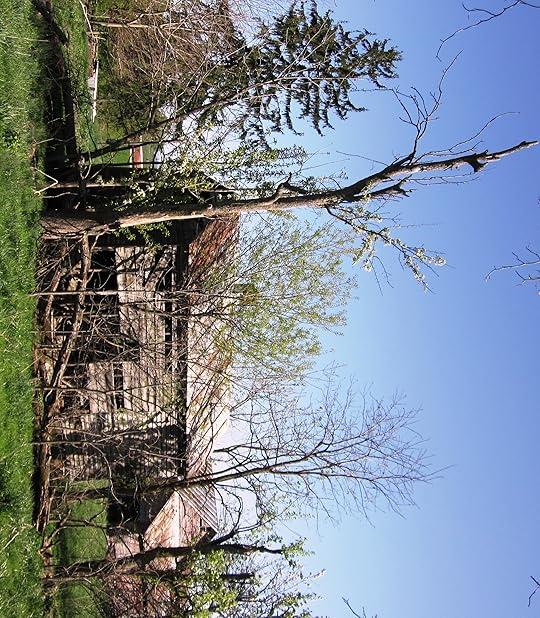 Behind our farm is a large field that lies fallow in the winter and is planted with corn and hay in the growing season. The edges of it are grown up in weeds and wild flowers. The land slants uphill and meets tree- covered hills at the top of this wide swathe of land. Nearer to the base of the field, just on the other side of our property, is a derelict 19th century barn where stray cats, possums, raccoons, birds, foxes, and sometimes coyotes hangout. A red-tailed hawk patrols overhead and it's a good place to see birds. Tall, seemingly random trees enclose the site where the house once stood. This first picture was taken in the spring when it's a fairly benign place to be. Not so much on an eerie fall evening.
Behind our farm is a large field that lies fallow in the winter and is planted with corn and hay in the growing season. The edges of it are grown up in weeds and wild flowers. The land slants uphill and meets tree- covered hills at the top of this wide swathe of land. Nearer to the base of the field, just on the other side of our property, is a derelict 19th century barn where stray cats, possums, raccoons, birds, foxes, and sometimes coyotes hangout. A red-tailed hawk patrols overhead and it's a good place to see birds. Tall, seemingly random trees enclose the site where the house once stood. This first picture was taken in the spring when it's a fairly benign place to be. Not so much on an eerie fall evening.
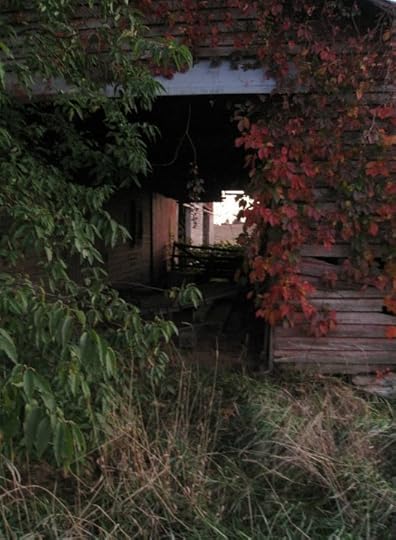 The farmhouse burned down in the 70′s and nearly consumed the old drunk who lived there with it, but he was rescued and stayed with my husband's family for a time. The foundation of the house, an old cellar, and outbuilding remain. Everything's overgrown and covered in vines. The place has an abandoned look and a decidedly creepy feeling about it. To the point where last fall my art major daughter Elise, my 13 yr old niece Elizabeth, and I (at my suggestion) decided to venture across our side of the land to the old barn and take some pictures at dusk. Why not, we thought, feeling adventurous.
The farmhouse burned down in the 70′s and nearly consumed the old drunk who lived there with it, but he was rescued and stayed with my husband's family for a time. The foundation of the house, an old cellar, and outbuilding remain. Everything's overgrown and covered in vines. The place has an abandoned look and a decidedly creepy feeling about it. To the point where last fall my art major daughter Elise, my 13 yr old niece Elizabeth, and I (at my suggestion) decided to venture across our side of the land to the old barn and take some pictures at dusk. Why not, we thought, feeling adventurous.
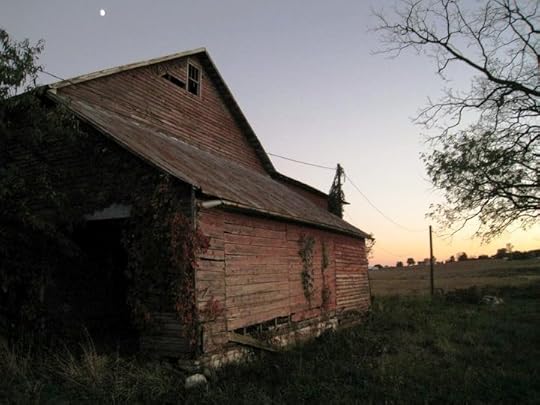 We brought a flashlight, our intent being to stay until dark and have Elise take more pics with her camera of–we weren't sure what–orbs maybe, before venturing home. Some people believe sites with strong paranormal activity produce orbs that show up in photographs while not necessarily visible to the naked eye. There was just one problem with this plan. We're chicken hearts.
We brought a flashlight, our intent being to stay until dark and have Elise take more pics with her camera of–we weren't sure what–orbs maybe, before venturing home. Some people believe sites with strong paranormal activity produce orbs that show up in photographs while not necessarily visible to the naked eye. There was just one problem with this plan. We're chicken hearts.
 Apparently the old man who lived at that farm until his death (several decades ago) stored newspapers in the barn. We chanced upon a small fragment of newspaper lying in the grass with the words The Devil printed on it. That rather took us aback. We looked more closely and discovered this snippet came from an ancient review of the horror movie, The Exorcist. But why did only that eerie snippet remain? Is that all it was, just a coincidence, or a warning? Who knows, we didn't hang around to discover. Later, the coyotes came out and we were doubly glad to have headed on home.
Apparently the old man who lived at that farm until his death (several decades ago) stored newspapers in the barn. We chanced upon a small fragment of newspaper lying in the grass with the words The Devil printed on it. That rather took us aback. We looked more closely and discovered this snippet came from an ancient review of the horror movie, The Exorcist. But why did only that eerie snippet remain? Is that all it was, just a coincidence, or a warning? Who knows, we didn't hang around to discover. Later, the coyotes came out and we were doubly glad to have headed on home.
Do I think there's something strange about that place? Yes, but I'm not bold enough to do any ghost hunting. I don't know how those who do have the nerve.
Filed under: Uncategorized Tagged: Arts, Barn, Barnes & Noble, Borders Group, Exorcist, Horror film, Nook, Red-tailed Hawk, the Devil








February 21, 2011
Mad About Mint
 All sorts of mint. We have a local no name variety that has been here since long before my time. Mint returns reliably and spreads like crazy but we are devotees so don't mind. Plus, we have plenty of room. In addition to the nameless kind, we grow chocolate mint which smells incredible and Egyptian mint, also lovely, and then there's the tall horsey mint I brought with me years ago from my mother's garden. It may be called Apple Mint, seems like I recall that name. The runners crept under the wall of the small greenhouse my husband built for me and grows in there now. That gets too invasive, but it's also a desirable variety, whatever it is. And then there's catmint, which is related to catnip and makes a fragrant, appealing addition to the herb/flower gardens. More on catnip later in this session.
All sorts of mint. We have a local no name variety that has been here since long before my time. Mint returns reliably and spreads like crazy but we are devotees so don't mind. Plus, we have plenty of room. In addition to the nameless kind, we grow chocolate mint which smells incredible and Egyptian mint, also lovely, and then there's the tall horsey mint I brought with me years ago from my mother's garden. It may be called Apple Mint, seems like I recall that name. The runners crept under the wall of the small greenhouse my husband built for me and grows in there now. That gets too invasive, but it's also a desirable variety, whatever it is. And then there's catmint, which is related to catnip and makes a fragrant, appealing addition to the herb/flower gardens. More on catnip later in this session.
 As to making tea, we find its best to gather the leaves on a sunny day after the dew has dried, about mid-morning. If you wait until too late in the day the essential oils that give the best flavor will have dissipated. Wash and blot the leaves then stuff them into a glass or porcelain container, not metal or plastic, (we use large mouthed canning jars) and pour boiling water over the leaves and allow them to steep. After about 20 minutes we drain the brew and dilute with water if it's too strong and sweeten to our liking, or mix the mint tea with regular tea to flavor it. If you use a glass jar, stick a metal knife or spoon inside with the leaves before pouring the hot water in to keep the container from cracking. You can also dry the leaves for winter use. Mint tea is soothing to my stomach. Don't give strong mint tea to infants/toddlers without consulting a physician as I did when my daughter was ten months old and it made her break out in hives around her mouth.
As to making tea, we find its best to gather the leaves on a sunny day after the dew has dried, about mid-morning. If you wait until too late in the day the essential oils that give the best flavor will have dissipated. Wash and blot the leaves then stuff them into a glass or porcelain container, not metal or plastic, (we use large mouthed canning jars) and pour boiling water over the leaves and allow them to steep. After about 20 minutes we drain the brew and dilute with water if it's too strong and sweeten to our liking, or mix the mint tea with regular tea to flavor it. If you use a glass jar, stick a metal knife or spoon inside with the leaves before pouring the hot water in to keep the container from cracking. You can also dry the leaves for winter use. Mint tea is soothing to my stomach. Don't give strong mint tea to infants/toddlers without consulting a physician as I did when my daughter was ten months old and it made her break out in hives around her mouth.
More on brewing tea: For a single cup of tea put a small amount into a tea ball, infuser, or tea bag, cover with hot water and steep until it reaches the desired strength. Herbal teas will give you more of the herbs benefits if you steep for at least 5 to 20 minutes.~
Now, onto the herbal lore and historic medicinal uses which will, no doubt, astound you.
From A Modern Herbal: (Bear in mind that by 'modern' she means early 20th century, so this is not all current medical thinking)
 The common garden mint is originally a native of the Mediterranean region, and was introduced into Britain by the Romans, being largely cultivated not only by them, but also by the other Mediterranean nations. It was in great request by the Romans, and Pliny according to Gerard says of it: 'The smell of Mint does stir up the minde and the taste to a greedy desire of meate.' Ovid represents the hospitable Baucis and Philemon scouring their board with green mint before laying upon it the food intended for their divine guests. The Ancients believed that mint would prevent the coagulation of milk and its acid fermentation. Gerard, again quoting Pliny, says:
The common garden mint is originally a native of the Mediterranean region, and was introduced into Britain by the Romans, being largely cultivated not only by them, but also by the other Mediterranean nations. It was in great request by the Romans, and Pliny according to Gerard says of it: 'The smell of Mint does stir up the minde and the taste to a greedy desire of meate.' Ovid represents the hospitable Baucis and Philemon scouring their board with green mint before laying upon it the food intended for their divine guests. The Ancients believed that mint would prevent the coagulation of milk and its acid fermentation. Gerard, again quoting Pliny, says:
'It will not suffer milk to cruddle in the stomach, and therefore it is put in milk that is drunke, lest those that drinke thereof should be strangled.'
Many other references to it in old writings – among them, that of the payment by the Pharisees of tithes of Mint, Anise and Cumin – prove that the herb has been highly esteemed for many centuries. Mint is mentioned in all early mediaeval lists of plants; it was very early grown in English gardens, and was certainly cultivated in the Convent gardens of the ninth century. Chaucer refers to 'a little path of mintes full and fenill greene. '
Turner states in his Herball (1568) that the garden mint of his time was also called 'Spere Mynte.' Gerard, in further praise of the herb, tells us that: 'the smelle rejoiceth the heart of man, for which cause they used to strew it in chambers and places of recreation, pleasure and repose, where feasts and banquets are made.'
 It has, in fact, been so universally esteemed, that it is to be found wild in nearly all the countries to which civilization has extended, and in America for 200 years it has been known as an escape from gardens, growing in moist soils and proving sometimes troublesome as a weed.
It has, in fact, been so universally esteemed, that it is to be found wild in nearly all the countries to which civilization has extended, and in America for 200 years it has been known as an escape from gardens, growing in moist soils and proving sometimes troublesome as a weed.
Parkinson, in his Garden of Pleasure, mentions 'divers sorts of mintes both of the garden and wilde, of the woods, mountain and standing pools or waters' and says: 'Mintes are sometimes used in Baths with Balm and other herbs as a help to comfort and strengthen the nerves and sinews. It is much used either outwardly applied or inwardly drunk to strengthen and comfort weak stomackes.'
The Ancients used mint to scent their bath water and as a restorative, as we use smelling salts to-day. In Athens where every part of the body was perfumed with a different scent mint was specially designated to the arms.
Gerard says of its medicinal properties: 'It is good against watering eies and all manner of breakings out on the head and sores. It is applied with salt to the bitings of mad dogs…. They lay it on the stinging of wasps and bees with good success.'
 Culpepper gives nearly forty distinct maladies for which mint is 'singularly good.' 'Being smelled into,' he says, 'it is comfortable for the head and memory, and a decoction when used as a gargle, cures the mouth and gums, when sore.' Again, 'Garden Mint is most useful to wash children's heads when the latter are inclined to sores, and Wild Mint, mixed with vinegar is an excellent wash to get rid of scurf. Rose leaves and mint, heated and applied outwardly cause rest and sleep.'
Culpepper gives nearly forty distinct maladies for which mint is 'singularly good.' 'Being smelled into,' he says, 'it is comfortable for the head and memory, and a decoction when used as a gargle, cures the mouth and gums, when sore.' Again, 'Garden Mint is most useful to wash children's heads when the latter are inclined to sores, and Wild Mint, mixed with vinegar is an excellent wash to get rid of scurf. Rose leaves and mint, heated and applied outwardly cause rest and sleep.'
In the fourteenth century, mint was used for whitening the teeth, and its distilled oil is still used to flavour tooth-pastes, etc., and in America, especially, to flavour confectionery, chewing gums, and also to perfume soap. Mint ottos have more power than any other aromatic to overcome the smell of tobacco. The application of a strong decoction of Spearmint is said to cure chapped hands. Mice are so averse to the smell of mint, either fresh or dried, that they will leave untouched any food where it is scattered.
 It is probable that Spearmint was introduced by the Pilgrim Fathers when they landed in America, as it is mentioned among many other plants brought out from England, in a list given by John Josselyn. When in this country apparently found growing wild, it occurs in watery places, but is rather rare.
It is probable that Spearmint was introduced by the Pilgrim Fathers when they landed in America, as it is mentioned among many other plants brought out from England, in a list given by John Josselyn. When in this country apparently found growing wild, it occurs in watery places, but is rather rare.
Professor Henslow (Origin and History of our Garden Vegetables) does not consider it truly native to any country. He says: 'The Garden Mint (Mentha viridis, Linn.) is a cultivated form of M. sylvestris (Linn.), the Horse Mint, which is recorded as cultivated at Aleppo. Either M. sylvestris, or some form approaching M. viridis, which is not known as a truly wild plant, was probably the mint of Scripture.'
Bentham also considers it not improbably a variety of M. sylvestris, perpetuated through its ready propagation by suckers, and though these two plants are sufficiently distinct as found in England, yet continental forms occur which bridge over their differences.
 Its generic name, Mentha, is derived from the mythological origin ascribed to it, and was originally applied to the mint by Theophrastus. Menthe was a nymph, who because of the love Pluto bore her, was metamorphosed by Proserpine, from motives of jealousy, into the plant we now call mint.
Its generic name, Mentha, is derived from the mythological origin ascribed to it, and was originally applied to the mint by Theophrastus. Menthe was a nymph, who because of the love Pluto bore her, was metamorphosed by Proserpine, from motives of jealousy, into the plant we now call mint.
*A bit more about peppermint: Ms. Grieve says, "Pliny tells us that the Greeks and Romans crowned themselves with Peppermint at their feasts and adorned their tables with its sprays, and that their cooks flavoured both their sauces and their wines with its essence. Two species of mint were used by the ancient Greek physicians, but some writers doubt whether either was the modern Peppermint, though there is evidence that M. piperita was cultivated by the Egyptians. It is mentioned in the Icelandic Pharmacopoeias of the thirteenth century, but only came into general use in the medicine of Western Europe about the middle of the eighteenth century, and then was first used in England.
 It was only recognized here as a distinct species late in the seventeenth century, when the great botanist, Ray, published it in the second edition of his Synopsis stirpium britannicorum, 1696. Its medicinal properties were speedily recognized, and it was admitted into the London Pharmacopceia in 1721, under M. piperitis sapore. The oldest existing Peppermint district is in the neighbourhood of Mitcham, in Surrey, where its cultivation from a commercial point of view dates from about 1750.
It was only recognized here as a distinct species late in the seventeenth century, when the great botanist, Ray, published it in the second edition of his Synopsis stirpium britannicorum, 1696. Its medicinal properties were speedily recognized, and it was admitted into the London Pharmacopceia in 1721, under M. piperitis sapore. The oldest existing Peppermint district is in the neighbourhood of Mitcham, in Surrey, where its cultivation from a commercial point of view dates from about 1750.
Peppermint oil is the most extensively used of all the volatile oils, both medicinally and commercially. The characteristic anti-spasmodic action of the volatile oil is more marked in this than in any other oil, and greatly adds to its power of relieving pains arising in the alimentary canal.
From its stimulating, stomachic and carminative properties, it is valuable in certain forms of dyspepsia, being mostly used for flatulence and colic. It may also be employed for other sudden pains and for cramp in the abdomen; wide use is made of Peppermint in cholera and diarrhoea.
It is generally combined with other medicines when its stomachic effects are required, being also employed with purgatives to prevent griping. Oil of Peppermint allays sickness and nausea, and is much used to disguise the taste of unpalatable drugs, as it imparts its aromatic characteristics to whatever prescription it enters into. It is used as an infants' cordial.
 The oil itself is often given on sugar and added to pills, also a spirit made from the oil, but the preparation in most general use is Peppermint Water, which is the oil and water distilled together. Peppermint Water and spirit of Peppermint are official preparations of the British Pharmacopoeia. In flatulent colic, spirit of Peppermint in hot water is a good household remedy, also the oil given in doses of one or two drops on sugar.
The oil itself is often given on sugar and added to pills, also a spirit made from the oil, but the preparation in most general use is Peppermint Water, which is the oil and water distilled together. Peppermint Water and spirit of Peppermint are official preparations of the British Pharmacopoeia. In flatulent colic, spirit of Peppermint in hot water is a good household remedy, also the oil given in doses of one or two drops on sugar.
Peppermint is good to assist in raising internal heat and inducing perspiration, although its strength is soon exhausted. In slight colds or early indications of disease, a free use of Peppermint tea will, in most cases, effect a cure, an infusion of 1 ounce of the dried herb to a pint of boiling water being employed, taken in wineglassful doses; sugar and milk may be added if desired.
 An infusion of equal quantities of Peppermint herb and Elder flowers (to which either Yarrow or Boneset may be added) will banish a cold or mild attack of influenza within thirty-six hours, and there is no danger of an overdose or any harmful action on the heart. Peppermint tea is used also for palpitation of the heart. In cases of hysteria and nervous disorders, the usefulness of an infusion of Peppermint has been found to be well augmented by the addition of equal quantities of Wood Betony.~
An infusion of equal quantities of Peppermint herb and Elder flowers (to which either Yarrow or Boneset may be added) will banish a cold or mild attack of influenza within thirty-six hours, and there is no danger of an overdose or any harmful action on the heart. Peppermint tea is used also for palpitation of the heart. In cases of hysteria and nervous disorders, the usefulness of an infusion of Peppermint has been found to be well augmented by the addition of equal quantities of Wood Betony.~
*Herbal treatments can pose health risks in some instances, so check with your health care provider before undertaking any.
Filed under: Uncategorized








February 19, 2011
About Thyme
 "I know a bank where the wild thyme blows,
"I know a bank where the wild thyme blows,
Where oxlips and the nodding violet grows
Quite overcanopied with luscious woodbine,
With sweet musk-roses and with elgantine." ~ Shakespeare
Thyme: We love thyme and grow many different varieties…the creeping sorts with their various scents, lemon, nutmeg, caraway…the woolly kind that feels fuzzy beneath your fingers, the silver-edged and standard varieties that grow in the shape of small shrubs, all ideal for the front of the perennial flower border. However they don't always survive our winters her in the Shenandoah Valley so we are frequently adding new plants. It's safe to say we're mad about thyme.
The Garden Thyme is an 'improved' cultivated form of the Wild Thyme of the mountains of Spain and other European countries bordering on the Mediterranean, flourishing also in Asia Minor, Algeria and Tunis, and is a near relation to our own Wild Thyme (Thymus serpyllum), which has broader leaves (the margins not reflexed as in the Garden Thyme) and a weaker odour.
It is cultivated now in most countries with temperate climates, though we do not know at what period it was first introduced into northern countries. It was certainly commonly cultivated in England before the middle of the sixteenth century, and is figured and described by Gerard.
Description: T. vulgaris is a perennial with a woody, fibrous root. The plant has an agreeable aromatic smell and a warm pungent taste. The fragrance of its leaves is due to an essential oil, which gives it its flavouring value for culinary purposes, and is also the source of its medicinal properties. It is in flower from May to August.
 There are three varieties usually grown for use, the broad-leaved, narrow-leaved and variegated: the narrow-leaved, with small, greyish-green leaves, is more aromatic than the broad-leaved, and is also known as Winter or German Thyme. The fragrant Lemon Thyme, likewise grown in gardens, has a lemon flavour, and rather broader leaves than the ordinary Garden Thyme, is not recurved at the margins, and ranks as a variety of T. serpyllum, the Wild Thyme. It is of a more trailing habit and of still smaller growth than the common Garden Thyme, and keeps its foliage better in the winter, though is generally considered to be not as hardy as the common Thyme. Another variety, the Silver Thyme, is the hardiest of all and has perhaps the best flavour. There is a variety, also, called the Orange Thyme, which Dr. Kitchener, in The Cook's Oracle, describes as a delicious herb that deserves to be better known. This and other varieties of Thyme, including the Caraway Thyme, which was used to rub the baron of beef, before it was roasted, and so came to be called 'Herbe Baronne,' are all worth cultivating.
There are three varieties usually grown for use, the broad-leaved, narrow-leaved and variegated: the narrow-leaved, with small, greyish-green leaves, is more aromatic than the broad-leaved, and is also known as Winter or German Thyme. The fragrant Lemon Thyme, likewise grown in gardens, has a lemon flavour, and rather broader leaves than the ordinary Garden Thyme, is not recurved at the margins, and ranks as a variety of T. serpyllum, the Wild Thyme. It is of a more trailing habit and of still smaller growth than the common Garden Thyme, and keeps its foliage better in the winter, though is generally considered to be not as hardy as the common Thyme. Another variety, the Silver Thyme, is the hardiest of all and has perhaps the best flavour. There is a variety, also, called the Orange Thyme, which Dr. Kitchener, in The Cook's Oracle, describes as a delicious herb that deserves to be better known. This and other varieties of Thyme, including the Caraway Thyme, which was used to rub the baron of beef, before it was roasted, and so came to be called 'Herbe Baronne,' are all worth cultivating.
 The name Thyme, in its Greek form, was first given to the plant by the Greeks as a derivative of a word which meant 'to fumigate,' either because they used it as incense, for its balsamic odour, or because it was taken as a type of all sweet-smelling herbs. Others derive the name from the Greek word thumus, signifying courage, the plant being held in ancient and mediaeval days to be a great source of invigoration, its cordial qualities inspiring courage. The antiseptic properties of Thyme were fully recognized in classic times, there being a reference in Virgil's Georgics to its use as a fumigator, and Pliny tells us that, when burnt, it puts to flight all venomous creatures.
The name Thyme, in its Greek form, was first given to the plant by the Greeks as a derivative of a word which meant 'to fumigate,' either because they used it as incense, for its balsamic odour, or because it was taken as a type of all sweet-smelling herbs. Others derive the name from the Greek word thumus, signifying courage, the plant being held in ancient and mediaeval days to be a great source of invigoration, its cordial qualities inspiring courage. The antiseptic properties of Thyme were fully recognized in classic times, there being a reference in Virgil's Georgics to its use as a fumigator, and Pliny tells us that, when burnt, it puts to flight all venomous creatures.
 Lady Northcote (in The Herb Garden) says that among the Greeks, Thyme denoted graceful elegance; 'to smell of Thyme' was an expression of praise, applied to those whose style was admirable. It was an emblem of activity, bravery and energy, and in the days of chivalry it was the custom for ladies to embroider a bee hovering over a sprig of Thyme on the scarves they presented to their knights. In the south of France, Wild Thyme is a symbol of extreme Republicanism, tufts of it being sent with the summons to a Republican meeting.
Lady Northcote (in The Herb Garden) says that among the Greeks, Thyme denoted graceful elegance; 'to smell of Thyme' was an expression of praise, applied to those whose style was admirable. It was an emblem of activity, bravery and energy, and in the days of chivalry it was the custom for ladies to embroider a bee hovering over a sprig of Thyme on the scarves they presented to their knights. In the south of France, Wild Thyme is a symbol of extreme Republicanism, tufts of it being sent with the summons to a Republican meeting.
This little plant, so familiar also in its wild form, has never been known in England by any familiar name, though occasionally 'Thyme' is qualified in some way, such as 'Running Thyme,' or 'Mother-of-Thyme.' 'Mother Thyme' was probably derived from the use of the plant in uterine disorders, in the same way that 'Motherwort' (Leonurus Cardiaca) has received its popular name for use in domestic medicine.
 The affection of bees for Thyme is well known and the fine flavour of the honey of Mount Hymettus near Athens was said to be due to the Wild Thyme with which it was covered (probably T. vulgaris), the honey from this spot being of such especial flavour and sweetness that in the minds and writings of the Ancients, sweetness and Thyme were indissolubly united. 'Thyme, for the time it lasteth, yieldeth most and best honie and therefor in old time was accounted chief,' says an old English writer. Large clumps of either Garden or Wild Thyme may with advantage be grown in the garden about 10 feet away from the hives.
The affection of bees for Thyme is well known and the fine flavour of the honey of Mount Hymettus near Athens was said to be due to the Wild Thyme with which it was covered (probably T. vulgaris), the honey from this spot being of such especial flavour and sweetness that in the minds and writings of the Ancients, sweetness and Thyme were indissolubly united. 'Thyme, for the time it lasteth, yieldeth most and best honie and therefor in old time was accounted chief,' says an old English writer. Large clumps of either Garden or Wild Thyme may with advantage be grown in the garden about 10 feet away from the hives.
Though apparently not in general use as a culinary herb among the ancients, it was employed by the Romans to give an aromatic flavour to cheese (and also to liqueurs)
 According to Culpepper, Thyme is: 'a noble strengthener of the lungs, as notable a one as grows, nor is there a better remedy growing for hooping cough. It purgeth the body of phlegm and is an excellent remedy for shortness of breath. It is so harmless you need not fear the use of it. An ointment made of it takes away hot swellings and warts, helps the sciatica and dullness of sight and takes away any pains and hardness of the spleen: it is excellent for those that are troubled with the gout and the herb taken anyway inwardly is of great comfort to the stomach.'
According to Culpepper, Thyme is: 'a noble strengthener of the lungs, as notable a one as grows, nor is there a better remedy growing for hooping cough. It purgeth the body of phlegm and is an excellent remedy for shortness of breath. It is so harmless you need not fear the use of it. An ointment made of it takes away hot swellings and warts, helps the sciatica and dullness of sight and takes away any pains and hardness of the spleen: it is excellent for those that are troubled with the gout and the herb taken anyway inwardly is of great comfort to the stomach.'
Gerard says it will 'cure sciatica and pains in the head,' and is healing in leprosy and the falling sickness.
 Oil of Thyme is employed as a rubefacient and counter-irritant in rheumatism, etc. Thyme enters into the formula for Herb Tobacco, and employed in this form is good for digestion, headache and drowsiness. In Perfumery, Essence of Thyme is used for cosmetics and rice powder. It is also used for embalming corpses. The dried flowers have been often used in the same way as lavender, to preserve linen from insects.
Oil of Thyme is employed as a rubefacient and counter-irritant in rheumatism, etc. Thyme enters into the formula for Herb Tobacco, and employed in this form is good for digestion, headache and drowsiness. In Perfumery, Essence of Thyme is used for cosmetics and rice powder. It is also used for embalming corpses. The dried flowers have been often used in the same way as lavender, to preserve linen from insects.
In this country, Thyme is principally in request for culinary requirements, for its use in flavouring stuffings, sauces, pickles, stews, soups, jugged hare, etc. The Spaniards infuse it in the pickle with which they preserve their olives.
All the different species of Thyme and Marjoram yield fragrant oils extensively used by manufacturing perfumers for scenting soaps. When dried and ground, they enter into the composition of sachet powders.
 THYMOL, a most valuable crystalline phenol, is the basis of the fragrant volatile Essence of Sweet Thyme. Thymol is a powerful antiseptic for both internal and external use; it is also employed as a deodorant and local anesthetic. It is extensively used to medicate gauze and wool for surgical dressings. It resembles carbolic acid in its action, but is less irritant to wounds, while its germicidal action is greater. It is therefore preferable as a dressing and during recent years has been one of the most extensively used antiseptics. (*By recent wars, I think she means WW1 and WW11).~
THYMOL, a most valuable crystalline phenol, is the basis of the fragrant volatile Essence of Sweet Thyme. Thymol is a powerful antiseptic for both internal and external use; it is also employed as a deodorant and local anesthetic. It is extensively used to medicate gauze and wool for surgical dressings. It resembles carbolic acid in its action, but is less irritant to wounds, while its germicidal action is greater. It is therefore preferable as a dressing and during recent years has been one of the most extensively used antiseptics. (*By recent wars, I think she means WW1 and WW11).~
Filed under: Uncategorized Tagged: Gardens, Herb, Kitchen garden, Leonurus Cardiaca, Plant, Thyme, Thymus serpyllum, Thymus vulgaris








February 16, 2011
There's Rosemary, That's For Remembrance
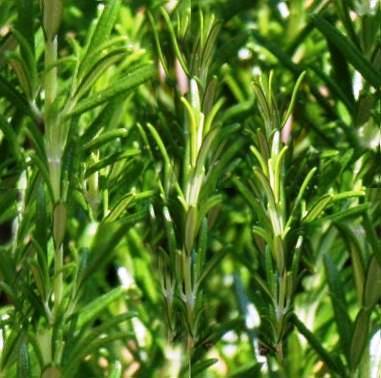 "There's rosemary and rue. These keep
"There's rosemary and rue. These keep
Seeming and savor all the winter long.
Grace and remembrance be to you."
- William Shakespeare (Winter's Tale, Act 4, Scene 4)
I love rosemary both for its scent and wonderful history. I'm never without at least a modest plant. My current specimen is rather pathetic. It's been a long, cold winter on my window sill. Even my sun space was too frigid this year.
Rodale's Illustrated Encyclopedia of Herbs says: "For centuries people thought that a rosemary plant would grow to higher than 6 feet in 35 years so as to not to stand taller than Christ. Another story tells that the flowers were originally thought to be white but changed to blue when the Virgin Mary hung her cloak on a bush while fleeing from Herod's soldiers with the Christ child.
Rosemary possessed powers of protection against evil spirits, or so people thought. In the Middle Ages, men and women would place sprigs under their pillows to ward off demons and prevent bad dreams.
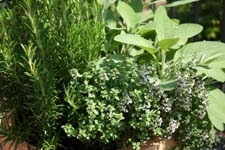 "There's rosemary that's for remembrance. Pray, you love, remember." ~ Hamlet
"There's rosemary that's for remembrance. Pray, you love, remember." ~ Hamlet
Rosemary is one of my favorite herbs, mostly just because. I rarely cook with it, but love its scent and the wealth of history behind it. Known as the herb of remembrance from the time of ancient Greece, it appears in that immoral verse by Shakespeare. My fascination with herbs plays a significant role in my historical/light paranormal romance Somewhere My Love, as does Hamlet, for that matter. I always wanted to write a murder mystery with a focus on herbs and parallels to a Shakespearean play, and so I did.
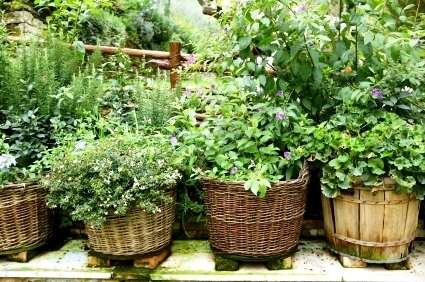 Regarding Rosemary, Maud Grieve says in A Modern Herbal,
Regarding Rosemary, Maud Grieve says in A Modern Herbal,
"The Ancients were well acquainted with the shrub, which had a reputation for strengthening the memory. On this account it became the emblem of fidelity for lovers. It holds a special position among herbs from the symbolism attached to it. Not only was it used at weddings, but also at funerals, for decking churches and banqueting halls at festivals, as incense in religious ceremonies, and in magical spells.
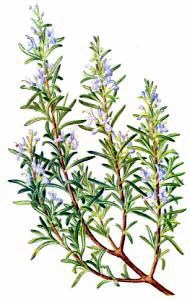 At weddings, it was entwined in the wreath worn by the bride, being first dipped into scented water. Anne of Cleves, we are told, wore such a wreath at her wedding. A Rosemary branch, richly gilded and tied with silken ribands of all colours, was also presented to wedding guests, as a symbol of love and loyalty. Together with an orange stuck with cloves it was given as a New Year's gift…
At weddings, it was entwined in the wreath worn by the bride, being first dipped into scented water. Anne of Cleves, we are told, wore such a wreath at her wedding. A Rosemary branch, richly gilded and tied with silken ribands of all colours, was also presented to wedding guests, as a symbol of love and loyalty. Together with an orange stuck with cloves it was given as a New Year's gift…
In early times, Rosemary was freely cultivated in kitchen gardens and came to represent the dominant influence of the house mistress, 'Where Rosemary flourished, the woman ruled.'
The Treasury of Botany says:
'There is a vulgar belief in Gloucestershire and other counties, that Rosemary will not grow well unless where the mistress is "master"; and so touchy are some of the lords of creation upon this point, that we have more than once had reason to suspect them of privately injuring a growing rosemary in order to destroy this evidence of their want of authority.'
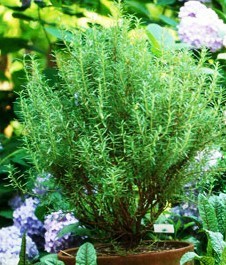 Rosemary was one of the cordial herbs used to flavour ale and wine. It was also used in Christmas decoration.
Rosemary was one of the cordial herbs used to flavour ale and wine. It was also used in Christmas decoration.
"Down with the rosemary and so,
Down with the baies and mistletoe,
Down with the holly, ivie all
Wherewith ye deck the Christmas Hall." —HERRICK.
"As for rosemary, I let it run all over my garden walls, not only because my bees love it but because it is the herb sacred to remembrance and to friendship, whence a sprig of it hath a dumb language."
- Sir Thomas More (1478-1535) British writer, statesman and philosopher
 Miss Ainslie gathered a bit of rosemary, crushing it between her white fingers. "See," she said, "some of us are like that it takes a blow to find the sweetness in our souls."
Miss Ainslie gathered a bit of rosemary, crushing it between her white fingers. "See," she said, "some of us are like that it takes a blow to find the sweetness in our souls."
Lavender and Old Lace
-Myrtle Reed (1874–1911)
Filed under: Uncategorized Tagged: Herb, Mary (mother of Jesus), Maud Grieve, Middle Ages, Rodale's Illustrated Encyclopedia of Herbs, Rosemary, The Winter's Tale, William Shakespeare














